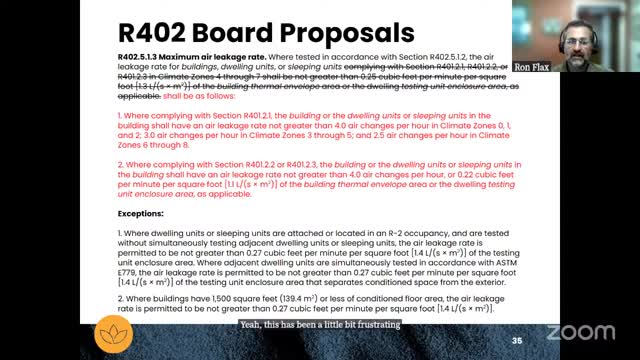Building Board discusses alternative metrics for air leakage compliance
December 12, 2024 | Energy Office, State Agencies, Organizations, Executive, Colorado
This article was created by AI summarizing key points discussed. AI makes mistakes, so for full details and context, please refer to the video of the full meeting. Please report any errors so we can fix them. Report an error »

On December 12, 2024, the Colorado State Legislature convened the Energy Code Board to discuss significant updates to the Low Energy and Carbon Code. The meeting focused on the metrics used to measure air leakage in buildings, a critical factor in energy efficiency and environmental impact.
A key point of contention was the ongoing debate between using Air Changes per Hour (ACH) and Equivalent Leakage Area (ELA) as metrics for compliance. Board member Ron emphasized the industry's long-standing familiarity with ACH, suggesting that while ELA could be a viable alternative, it might be beneficial to allow both metrics as options for compliance. This dual approach could particularly aid smaller homes, which often struggle to meet stringent ACH requirements.
Brad supported Ron's proposal, noting that Fort Collins has successfully implemented ELA in their building codes, allowing for a more equitable assessment of air leakage in smaller units. He pointed out that many industry professionals are already accustomed to using ELA, especially in multifamily buildings, indicating a growing acceptance of this metric.
However, concerns were raised about the potential confusion that could arise from introducing a new metric. Kim highlighted that while the industry is becoming familiar with ACH, transitioning to ELA could set back progress made over the past decade. Andrew echoed this sentiment, cautioning that significant changes in metrics could lead to compliance challenges, particularly for single-family homes.
The board ultimately decided to conduct a straw poll to gauge support for maintaining ACH as the primary metric while allowing for ELA as an alternative. The results showed a strong preference for keeping both options available, reflecting a consensus on the need for flexibility in compliance pathways.
In addition to the air leakage discussion, the board also addressed proposals related to insulation quality in high-altitude climates. Kim proposed clarifying installation standards to ensure that insulation meets performance requirements, particularly in homes that do not undergo rigorous third-party inspections. However, this proposal faced scrutiny regarding its potential to conflict with existing codes and standards.
The meeting concluded with a commitment to refine the language in the code to incorporate both ACH and ELA as compliance options, while also considering the implications of insulation standards. The board's discussions underscored the ongoing efforts to balance energy efficiency goals with practical implementation challenges in the building industry. As the board moves forward, the focus will remain on ensuring that new regulations are both effective and achievable for builders and homeowners alike.
A key point of contention was the ongoing debate between using Air Changes per Hour (ACH) and Equivalent Leakage Area (ELA) as metrics for compliance. Board member Ron emphasized the industry's long-standing familiarity with ACH, suggesting that while ELA could be a viable alternative, it might be beneficial to allow both metrics as options for compliance. This dual approach could particularly aid smaller homes, which often struggle to meet stringent ACH requirements.
Brad supported Ron's proposal, noting that Fort Collins has successfully implemented ELA in their building codes, allowing for a more equitable assessment of air leakage in smaller units. He pointed out that many industry professionals are already accustomed to using ELA, especially in multifamily buildings, indicating a growing acceptance of this metric.
However, concerns were raised about the potential confusion that could arise from introducing a new metric. Kim highlighted that while the industry is becoming familiar with ACH, transitioning to ELA could set back progress made over the past decade. Andrew echoed this sentiment, cautioning that significant changes in metrics could lead to compliance challenges, particularly for single-family homes.
The board ultimately decided to conduct a straw poll to gauge support for maintaining ACH as the primary metric while allowing for ELA as an alternative. The results showed a strong preference for keeping both options available, reflecting a consensus on the need for flexibility in compliance pathways.
In addition to the air leakage discussion, the board also addressed proposals related to insulation quality in high-altitude climates. Kim proposed clarifying installation standards to ensure that insulation meets performance requirements, particularly in homes that do not undergo rigorous third-party inspections. However, this proposal faced scrutiny regarding its potential to conflict with existing codes and standards.
The meeting concluded with a commitment to refine the language in the code to incorporate both ACH and ELA as compliance options, while also considering the implications of insulation standards. The board's discussions underscored the ongoing efforts to balance energy efficiency goals with practical implementation challenges in the building industry. As the board moves forward, the focus will remain on ensuring that new regulations are both effective and achievable for builders and homeowners alike.
View full meeting
This article is based on a recent meeting—watch the full video and explore the complete transcript for deeper insights into the discussion.
View full meeting
